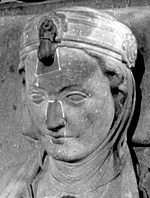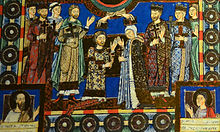Matilda of England was the eldest daughter and third child of, arguably, Medieval Europe’s most glamorous couple. Born in London in June 1156, the daughter of Eleanor of Aquitaine and Henry II was baptised by Theobald, Archbishop of Canterbury, in the Priory Church of the Holy Trinity, Aldgate.
As her parents ruled an empire, that stretched from the Scottish borders to the Pyrenees, travel was a constant part of Matilda’s childhood. She took her first sea-voyage across the English Channel at just 2 months old with her mother and older brother, Henry, to join her father in Anjou; before travelling to Aquitaine in October.
Throughout her childhood, Matilda is often seen accompanying her mother throughout the vast Angevin domains. She and Henry would be joined in the nursery by 3 younger brothers – Richard, Geoffrey and John – and 2 younger sisters – Eleanor and Joan – who survived into adulthood.
Negotiations began for Matilda’s marriage in February 1165, as part of an alliance with the German Emperor, Frederick Barbarossa, in opposition to Louis VII of France and the Pope, Alexander III. It was one of a series of dynastic marriages, which included her younger sisters, aimed at strengthening their father’s position in Europe.
The first of her parents’ daughters to be married, her dowry and send-off cost around £4,500 (about a quarter of England’s annual revenue). The money was raised by taxes specifically levied for the occasion. The 12-year-old princess was given a trousseau worth £63 , including saddles with gilt fittings, ‘two large silken cloths, and two tapestries and one cloth of samite and twelve sable skins’. 34 packhorses were needed to transport all her belongings.
In July 1166 the emperor’s envoys arrived in England, to escort Matilda to Germany. Her mother accompanied her to Dover, where she embarked on a German ship; and the wedding to Henry V ‘the Lion’, Duke of Saxony and Bavaria, finally took place in Minden Cathedral, Germany, on 1st february 1168.
Henry the Lion was 27 years Matilda’s senior, his first marriage, to Klementia of Zahringen, had been annulled in 1162. The marriage appears to have been successful and produced 10 children, although the fates of some seem to be in question, and several did not survive childhood. Their eldest daughter, Richenza (her name was later changed to Matilda), born around 1172, was married firstly to Geoffrey III, Count of Perche, and secondly to Enguerrand III, Lord of Coucy.
Of their sons Henry, born in 1173, would succeed to the Duchies of Saxony and Bavaria on his father’s death in 1195. Born around 1175, their second son, Otto, Earl of York and Count of Ponthieu, would become Holy Roman Emperor as Otto IV in 1209; Otto was briefly considered as heir to the English throne, by his uncle Richard I, before King John claimed the crown. A third son, William, Duke of Luneberg and Brunswick, was born in England in 1184 and would be ancestor, in the direct male line, of the House of Hanover, Kings of Great Britain in the 18th Century.
In 1180 Henry V quarrelled with the Holy Roman Emperor, Frederick Barbarossa, who held him responsible for the failure of a campaign in Italy. Henry, it seems, had grown very powerful in his own domains and Barbarossa, after the quarrel, deprived him of his fiefs and sent the Duke of Saxony and Bavaria into exile for 7 years.
Henry, Matilda and their children left Germany and sought refuge at the Angevin court in Autumn 1181. Henry II welcomed his daughter to his court in Normandy and, whilst energetically lobbying the German emperor on his son-in-law’s behalf, gave his daughter the palace of Argentin as a family residence.
Matilda was heavily pregnant and remained with her father whilst her husband left on pilgrimage to Compostela. The family was together again by Christmas 1182, spending the festive period with Matilda’s siblings at Henry II’s court in Caen.
Matilda and her family spent 1183 in the Angevin lands on the Continent; a pregnant Matilda accompanied her father to England in 1184, where she gave birth to her son, William, at Winchester in mid-June. While at the Angevin court Matilda was instrumental in getting the restrictions eased on her mother’s imprisonment; Eleanor of Aquitaine had been held at Old Sarum, following her complicity in a failed rebellion by her sons in 1173-4.
Although she was still in the custody of guards, Eleanor was allowed to reside with Matilda at various locations in England, including Windsor and Berkhamsted. When Eleanor was allowed to cross the Channel to take possession of the Vexin Castles, Matilda accompanied her.
In early 1185, having asked the Pope to intervene with the Emperor, Henry II finally secured agreement for his son-in-law to return to his German domains; although Henry would not be restored to Imperial favour until 1190, when he made peace with the new Holy Roman Emperor, Henry VI.
Matilda and Henry arrived back in Germany in October 1185, although their children, Otto, William and Matilda had been left at Henry’s court, to be raised by their grandparents.
Henry the Lion would be exiled from Germany again, when Frederick Barbarossa left on Crusade, but this time, Matilda remained to oversee their German domains.
Matilda died at Brunswick on 28th June 1189 and was buried there, in the Cathedral of St Blasius, of which she was co-foundress. Henry II died just 8 days later, probably before the news of his daughter’s death could reach him. Matilda’s husband would be buried alongside her, following his death on 6th August 1195.
There seems to be no surviving description of Matilda; however, Bertran de Born, troubadour to Matilda’s brother Richard (the Lionheart) composed a song about her and compared Matilda’s beauty to that of Helen of Troy.
*
Sources: Robert Bartlett England Under the Norman and Angevin Kings, 1075-1225; Alison Weir, Britain’s Royal Families; Mike Ashley The Mammoth Book of British Kings & Queens; David Williamson Brewer’s British Royalty; Douglas Boyd Eleanor, April Queen of Aquitaine; Alison Weir Eleanor of Aquitaine.
Pictures taken from Wikipedia.
*
My Books
Signed, dedicated copies of all my books are available, please get in touch by completing the contact me form.
Defenders of the Norman Crown: The Rise and Fall of the Warenne Earls of Surrey tells the fascinating story of the Warenne dynasty, of the successes and failures of one of the most powerful families in England, from its origins in Normandy, through the Conquest, Magna Carta, the wars and marriages that led to its ultimate demise in the reign of Edward III. Defenders of the Norman Crown: Rise and Fall of the Warenne Earls of Surrey is now available from Pen & Sword Books, Amazon in the UK and US, Bookshop.org and Book Depository.
1 family. 8 earls. 300 years of English history!
Also by Sharon Bennett Connolly:
Ladies of Magna Carta: Women of Influence in Thirteenth Century England looks into the relationships of the various noble families of the 13th century, and how they were affected by the Barons’ Wars, Magna Carta and its aftermath; the bonds that were formed and those that were broken. It is now available in paperback and hardback from Pen & Sword, Amazon, Bookshop.org and from Book Depository worldwide.
Heroines of the Medieval World tells the stories of some of the most remarkable women from Medieval history, from Eleanor of Aquitaine to Julian of Norwich. Available now from Amberley Publishing and Amazon, Bookshop.org and Book Depository.
Silk and the Sword: The Women of the Norman Conquest traces the fortunes of the women who had a significant role to play in the momentous events of 1066. Available now from Amazon, Amberley Publishing, Bookshop.org and Book Depository.
*
You can be the first to read new articles by clicking the ‘Follow’ button, liking our Facebook page or joining me on Twitter and Instagram.
©2015 Sharon Bennett Connolly FRHistS





